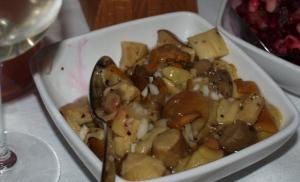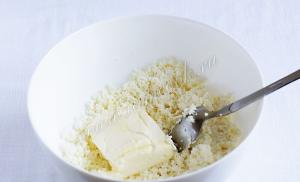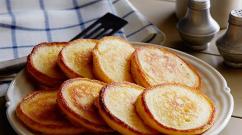Caucasian lily, Krasnodar region. Caucasian lily Caucasian lily
Lilium caucasicum (Miscz. ex Grossh.) Grossh. (L martagon subsp. caucasicum Miscz.)
Category and status: 2 a, b - a species that is declining in numbers as a result of strong anthropogenic impact.
Brief description. Bulbous perennial. Blooms in May-June, bears fruit in August. Propagated by seeds, less often vegetatively - by dividing bulbs and bulblets - children (1). 328 Liliaceae family
Spreading. In Russia, it occurs sporadically on the northern (very rare) and mainly on the southern macroslope of the western part of the Main Caucasus Range within the Krasnodar Territory (Goryachiy Klyuch, Apsheronsk, Tsitsa River, Shakhe-Mzymta watershed) and the Republic of Adygea. The southern part of the range lies outside Russia - in Georgia: Abkhazia, from where it is described as a subspecies (Apiancha), and in South-West Asia (Turkey) (2-4).
Features of ecology and phytocenology. Grows in oak, chestnut, beech forests, also indicated for yew-boxwood groves (5). A mesophilic species that lives in the lower and middle mountain zones in damp places under the canopy of deciduous forests.
Number. At least 25 locations are known in Russia. State of local populations. In the Tuapse and Sochi districts, where natural habitat conditions were not disturbed, flowering plants were observed, which indicated a satisfactory state of the species populations (b, 7).
Limiting factors. Ornamental plant. It is constantly destroyed in nature by people (digging up bulbs, collecting flowers for bouquets), the bulbs are knocked out and eaten by animals, but the main danger to the preservation of the species in nature is human economic activity and the destruction of natural habitats (7,8).
Security measures taken. It was included in the Red Books of the USSR (1978,1984) and the RSFSR (1988). The species is included in the Red Book of the Krasnodar Territory (1994) and the Republic of Adygea (2000). Part of its range is protected in the Caucasus Biosphere Reserve (5).
Necessary security measures. Creation of a reserve on the watershed of the Shakhe-Mzymta rivers (7,8). Prohibition of collecting and selling plants. Monitoring the state of populations. Possibility of cultivation. Cultivated in botanical gardens St. Petersburg (BIN RAS), Kirovsk (PABSI), Syktyvkar (SyktSU) and Pyatigorsk (BIN RAS station) (9). It is necessary to cultivate the species in botanical gardens and parks (and select varieties based on it).
Sources of information. 1. Kudryashova, 1971; 2. Baranova, 1990; 3. Davis, Henderson, 1984; 4. Semagina, 1999; 5. Zernov, 2002; b. Solodko, Kiriy, 2002; 7. Litvinskaya et al., 1983; 8. Red Book of the Krasnodar Territory, 1994; 9. Plants of the Red Book..., 2005. Compiled by: G.L. Kudryashova.
It grows in the central regions of the Greater Caucasus and in the western part of the Lesser Caucasus along forest edges and subalpine meadows, at altitudes from 800 to 2000 m or more. Named in honor of the expert on the flora of the Caucasus A. Szovits, who first found it in Transcaucasia in 1830.
The bulb is ovoid, 8–10 cm in diameter, the scales are broadly lanceolate, numerous, fleshy, golden-yellow, darkening in the light. The stem is 100–180 cm tall, straight, light green, 1–3 cm in diameter, pubescent with short hairs in the middle and lower parts, densely leafy. The leaves are light green, lanceolate, the middle leaves are up to 16 cm long, 2 cm wide, the lower leaves are 10 - 14 and 3.5 - 4 cm, respectively. The flowers are bell-shaped, fragrant, collected in racemes of 2 - 19 flowers, yellow with dark -purple spots located along the edge of the tepals. The peduncle is 6.5–7 cm long. The tepals bend spirally towards the end of flowering. The pollen is bright orange. Blooms in early June. Frost-resistant, blooms even in the Arctic. A feature of the flower, noted by G.L. Kudryashova, is the dense consistency of its lobes.
Violet- a variety bred by I.V. Michurin in 1914 as a result of crossing L. szovitsianum X L. thunbergianum. Plants up to 150 cm high. The inflorescence bears up to 20 flowers. The flowers are wide open, horizontally arranged, up to 8 cm in diameter, bright lilac-red, with a violet scent. Pollen is light brown. The stem is cylindrical, slightly ribbed, densely leafy. Leaves are alternate, lanceolate, 15-18 cm long. and up to 2 cm wide., bare or slightly pubescent along the veins below. The bulb is cone-shaped, up to 8 cm in diameter, with lanceolate yellowish scales. It blooms in early summer for 15-20 days. It is necessary to grow on humus soil, in semi-shaded areas. Quite frost-resistant, but in northern regions it should be covered in winter. Propagated by bulbous scales, which are planted in the fall (blooms in the 2-3rd year). Doesn't produce seeds. Tested: Kirovsk, Leningrad, Moscow, Michurinsk, Riga, Omsk, Gorno-Altaisk, Kuibyshev. It is of great interest for further hybridization as a pollinator.
For many years, the Soviet breeder Z. N. Tsvetaeva in Michurinsk was engaged in crossing violet with L. pensylvanicum. She has obtained many hybrids and varieties with flowers from orange-red to reddish-violet, from upright goblet-shaped to drooping.
Violet's daughter. Obtained by 3. N. Tsvetaeva in 1936.1 Plants up to 170 cm tall. The inflorescence bears up to 30 flowers. The flowers are bell-shaped, horizontally arranged, up to 10-12 cm in diameter, lilac-reddish-burgundy, with brown spots, with a violet aroma. The pollen is brown. The stem is cylindrical, glabrous. Leaves are alternate, lanceolate, 6-8 cm long. and 2 cm wide, pubescent along the edges. The bulb is round, up to 8-9 cm in diameter, with lanceolate light yellow scales. Blooms in early summer for 12-14 days. Frost-resistant. Grow in semi-shaded areas. They propagate by bulbous scales and baby bulbs, which form at the base of the stem underground.
In memory of Michurin. Obtained by Z. N. Tsvetaeva in 1936. Plants 160-170 cm tall. The inflorescence bears up to 20-25 flowers. The flowers are bell-shaped, slightly drooping, up to 10-11 cm in diameter, orange-red, with a pinkish-violet tint. The pollen is brown. The stem is cylindrical, glabrous. Leaves are alternate, lanceolate, 6-8 cm long. and 2 cm wide., naked. The bulb is round, up to 9 cm in diameter, with lanceolate light yellow scales. Blooms in early summer for 15 days. Frost-resistant, but when grown in the north, shelter is required in winter. Propagated by bulb scales and baby bulbs. Bears stem roots.
Zinaida. Obtained by Z. N. Tsvetaeva in 1936. Plants 150-160 cm tall. The inflorescence bears up to 30 flowers. The flowers are goblet-shaped, upward directed, up to 10 cm in diameter, dark red, with a pinkish-yellow base of the lobes. The pollen is brown. The stem is cylindrical, glabrous. Leaves are alternate, lanceolate, up to 15-18 cm long. and up to 2-3 cm wide, pubescent along the edges. The bulb is round, 6-7 cm in diameter, with lanceolate light yellow scales. It blooms in early summer for 10-12 days. Frost-resistant. Grow in semi-shaded areas. Bears stem roots. Propagated by bulbous scales and baby bulbs.
Photo by Mikhail Polotnov
Taxonomy
on Wikispecies
Images
on Wikimedia Commons
| ITIS | |
| NCBI | |
| EOL | |
| t:22185 | |
| IPNI | 537662-1 |
| TPL | kew-279985 |
Lily curly, or Curly saranka, or Royal curls, or Forest lily(lat. Lílium mártagon) - perennial bulbous plant; species of the genus Lilia.
Name
- Lilium caucasicum (Miscz. ex Grossh.) Grossh.- Caucasian lily [= Lilium martagon var. martagon]
- Lilium martagon subsp. caucasicum Miscz. ex Grossh.[= Lilium martagon var. martagon]
Curly lily is known by its popular names royal curls , sardana , saranka And saran , badun , oiler.
Distribution and ecology
Widely distributed from Europe to Northern Asia. The range is fragmented, its individual sections are located in the European part of Russia, in the Carpathians, in Transcarpathia, in the south of Western and Eastern Siberia.
It grows on mountain slopes, on forest edges, clearings and meadows. Found sporadically in mixed, broad-leaved and small-leaved forests, on rich, moderately moist soils; in the mountains - from the lower to the upper mountain belt.
Security status
Due to the fact that the species needs protection, protective measures were taken. Lily curly is a rare species of the flora of the Urals, listed in the regional report of Siberia (1980), the report of rare plants for Central Siberia (1979) and in the Red Book of the Republic of Mari El (1997).
Botanical classification

Lily curly on a USSR postage stamp, 1988
There are several subspecies of this lily.
Economic importance and application
The chemical composition of curly lily has been little studied. The presence of alkaloids in all parts of the plant, as well as saponins and flavonoids in the aerial parts, was noted. Bulbs contain a large amount of proteins, mucous substances, vitamins, sugars, iron, boron.
Lily has long been used as a medicinal plant in traditional medicines China, Tibet, Mongolia, Buryatia, Yakutia, Siberia and the Far East, where the juice of the bulbs is used as a wound-healing agent, and the infusion is used for toothache.
Traditionally, the species has nutritional value and is consumed raw, boiled, fried, dried and as a seasoning. “The bulbs are edible; in Siberia they are eaten raw or baked in ash, or boiled with milk and cow's butter. Dried bulbs of this and other types of lilies are used by the Yakuts in the form of flour to prepare milk porridge; The Kirghiz put onions in sheep's cheese for seasoning." Used as a coffee substitute.
In veterinary medicine, it is added to pet food to increase lactation and milk fat content.
Lily has long been used in cultivation as an ornamental plant. Plants in large quantities They are collected into bouquets, bulbs are dug up, which leads to the depletion of natural populations.
See also
Notes
- For the convention of indicating the class of monocots as a superior taxon for the group of plants described in this article, see the section “APG Systems” of the article “Monocots”.
- Russian name taxon - according to the following edition: Shroeter A. I., Panasyuk V. A. Dictionary of Plant Names = Dictionary of Plant Names / Int. union biol. Sciences, National Faculty of Biologists Russia, Vseros. Institute of Lec. and aromatic plants Ros. agricultural academies; Ed. prof. V. A. Bykova. - Koenigstein: Koeltz Scientific Books, 1999. - P. 146. - 1033 pp. - ISBN 3-87429-398-X.
- According to the site (see Links section).
- // Encyclopedic Dictionary of Brockhaus and Efron
- // Encyclopedic Dictionary of Brockhaus and Efron: in 86 volumes (82 volumes and 4 additional). - St. Petersburg. , 1890-1907.
- // Encyclopedic Dictionary of Brockhaus and Efron: in 86 volumes (82 volumes and 4 additional). - St. Petersburg. , 1890-1907.
, oiler.
Distribution and ecology
Widely distributed from Europe to Northern Asia. The range is fragmented, its individual sections are located in the European part of Russia, in the Carpathians, in Transcarpathia, in the south of Western and Eastern Siberia.
It grows on mountain slopes, on forest edges, clearings and meadows. Found sporadically in mixed, broad-leaved and small-leaved forests, on rich, moderately moist soils; in the mountains - from the lower to the upper mountain belt.
Security status
Due to the fact that the species needs protection, protective measures were taken. Lily curly is a rare species of the flora of the Urals, listed in the regional report of Siberia (1980), the report of rare plants for Central Siberia (1979) and in the Red Book of the Republic of Mari El (1997).
Botanical classification
Economic importance and application
The chemical composition of curly lily has been little studied. The presence of alkaloids in all parts of the plant, as well as saponins and flavonoids in the aerial parts, was noted. Bulbs contain a large amount of proteins, mucous substances, vitamins, sugars, iron, boron.
The curly lily has long been used as a medicinal plant in the folk medicine of China, Tibet, Mongolia, Buryatia, Yakutia, Siberia and the Far East, where the juice of the bulbs is used as a wound-healing agent, and the infusion is used for toothache.
Traditionally, the species has nutritional value and is consumed raw, boiled, fried, dried and as a seasoning. “The bulbs are edible; in Siberia they are eaten raw or baked in ash, or boiled with milk and cow's butter. Dried bulbs of this and other types of lilies are used by the Yakuts in the form of flour to prepare milk porridge; The Kirghiz put onions in sheep's cheese for seasoning." Used as a coffee substitute.
In veterinary medicine, it is added to pet food to increase lactation and milk fat content.
Lily has long been used in cultivation as an ornamental plant. Plants are collected in large quantities into bouquets, and bulbs are dug up, which leads to the depletion of natural populations.
See also
Notes
- For the convention of indicating the class of monocots as a superior taxon for the group of plants described in this article, see the section “APG Systems” of the article “Monocots”.
- The Russian name of the taxon is according to the following edition: Shroeter A. I., Panasyuk V. A. Dictionary of Plant Names = Dictionary of Plant Names / Int. union biol. Sciences, National Faculty of Biologists of Russia, Vseros. Institute of Lec. and aromatic plants Ros. agricultural academies; Ed. prof. V. A. Bykova. - Koenigstein: Koeltz Scientific Books, 1999. - P. 146. - 1033 pp. - ISBN 3-87429-398-X.
- According to the site (see Links section).
- // Encyclopedic Dictionary of Brockhaus and Efron
- // Encyclopedic Dictionary of Brockhaus and Efron: in 86 volumes (82 volumes and 4 additional). - St. Petersburg. , 1890-1907.
- // Encyclopedic Dictionary of Brockhaus and Efron: in 86 volumes (82 volumes and 4 additional). - St. Petersburg. , 1890-1907.
- // Encyclopedic Dictionary of Brockhaus and Efron: in 86 volumes (82 volumes and 4 additional). - St. Petersburg. , 1890-1907.
- Gubanov I. A. et al. Wild useful plants of the USSR / resp. ed. T. A. Rabotnov. - M.: Mysl, 1976. - P. 63-64. - 360 s. - (Reference books for geographers and travelers).
- Gorchakovsky P. L. Rare and endangered plants of the Urals and the Urals. - M., 1982. - 208 p.
- Jelitto, L., Schacht, W., Fessler, A. Die Freiland-Schmuckstauden. - Ulmer, 1998. - 683 p. -
Caucasian lily— Lilium martagon subsp. cauca-sicum Miscz. ex Grossh. 1928
Liliaceae family– Liliaceae
Global Threat Category on the IUCN Red List
Included in the IUCN Red List of Threatened Plants 1997 (Cambridge, 1997). World status: Indeterminate (I) .Category according to IUCN Red List criteria
Regional populations belong to the rarity category “Vulnerable” – Vulnerable, VU C2a(i); I. N. Timukhin, B. S. Tuniev.
Brief morphological characteristics
Bulbous herbaceous polycarpic. Height – up to 115 cm. Bulbs are broadly ovoid, up to 5 cm long. The bright yellow scales fit tightly to each other.
The stem is spotted in the upper part, rather densely pubescent with short, erect hairs. The leaves are obovate-lanceolate or elliptic-lanceolate, the lower ones are collected in whorls of 5–8, the upper ones are alternate, shorter.
Flowers of 5–8 are collected in a brush, drooping. The tepals are cherry-red with dark spots, oblong, up to 4 cm long, narrowed downwards. The stamens are 2 times shorter than the tepals. The anthers are dark purple.
The style is 2 times longer than the ovary, the stigma is tripartite. The ovary is sessile, narrow, three-locular. The box is 6-sided, with sharp edges. The seeds are numerous.
Spreading
General range: South-West Asia (Türkiye); Caucasus (Abkhazia). Russia: North Caucasus: RA (river Tsitsa, on Messo); KK.
Krasnodar region: Western Caucasus: Adagum-Pshishsky district (Kaluzhskaya station in the gorge 0.5 km from Mount Izvestkovaya (8.VI.1948, Kubina, Kosenko), in the vicinity of the city of Goryachiy Klyuch on the northeastern slope of the Kotkh ridge (1.VI.1982, S. Chukuridi), near the top of Mount Vyshka (14.VII.1945, Molchanov), env. Khadyzhensk);
Belo-Labinsky district (Tsitsa river, Montenegro plateau); Western Transcaucasia: Tuapse-Adler district (Shaumyansky lane, along the Tuapse river valley, Semiglavaya mountain, Bolshoi district Sochi, watershed of the river. Shahe – Mzymta, mountains Akhun, Aibga, Saharnaya, ur. Eagle Rocks, ridge. Uvarov, along the river. Tsuskvadzh, env. With. Volkonka, lane. Khakuj, thyssosamshit grove, r. Western Dagomys).
Features of biology, ecology and phytocenology
Blooms in May–June, bears fruit in August. Entomophile. Mesophyte, sciophyte, cryptophyte. It is found in broad-leaved (hornbeam, oak, chestnut, beech) forests at an altitude of 300–500 m above sea level. m. .
In the district of. Volkonka descends almost to the seashore, and at the lane. Khakuj reaches the upper border of the forest at an altitude of 1200 m above sea level. m. . In ur. Eagle Rocks SNP was recorded in dogwood-hornbeam oak forest on humus-carbonate highly crushed stone soil. On the northern slope of the lane. Shaumyansky (Tuapse forestry) grows in azalea-periwinkle oak forest.
Number and its trends
As a rule, it is found in small groups in small areas. Under optimal conditions, population density can reach 25 individuals. per 1 m2. The total area occupied by the cenopopulation in ur. Eagle Rocks - more than 10 hectares. On a site of 5 m2 – j:vv:g – 26:16:24.
The predominance of juvenile plants makes the cenopopulation left-sided and incomplete. Despite the incompleteness, we can talk about its high vitality. On the northern slope of the lane. The Shaumyan coenopopulation is large, covering an area of at least 20 hectares.
On a site of 5 m2 – j:vv:g – 56:19:54. The density in the KSPBZ is 15 individuals per 1 m2. Populations in the area Khadyzhensk incomplete. A significant number of individuals were destroyed during the construction of a pipeline along the river valley. Tuapse.
Limiting factors
Collection and digging of plants for decorative purposes, recreation, logging, disturbance of growing conditions, eating bulbs by wild boars; developmental biology.
Security measures
Protected in SNP and KSPBZ. Necessary in the environment. Shaumyan Pass to organize a botanical natural monument, limit anthropogenic load in places of growth, prohibit collection by the population, monitor the state of populations, study taxonomy, biology, ecology, geographical distribution, introduction into culture with subsequent reintroduction into natural communities.
Sources of information. 1. IUCN Red List... 1997; 2. Alekseev et al., 1988; 3. Kolakovsky, 1986; 4. Kosenko, 1970; 5. Kudryashova, 1971; 6.KBAI; 7. Personal communication, S. A. Litvinskaya; 8. KKKK, 1994; 9. Red Book of the RSFSR, 1988; 10. Red Book of the USSR, 1984; 11. Timukhin, 2002a; 12. Tuniev, Timukhin, 2001; 13. Data from the compilers; 14. Timukhin, 2003d; 15. Solodko, 1985. Compiled by I. N. Timukhin, B. S. Tuniev; rice. S. A. Litvinskaya.
This entry was posted in , . Bookmark the .













